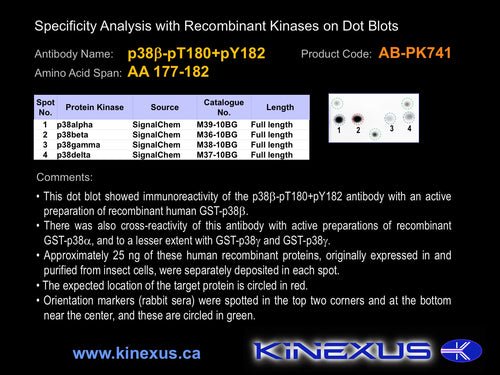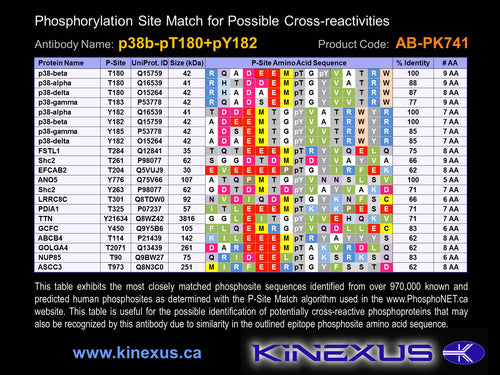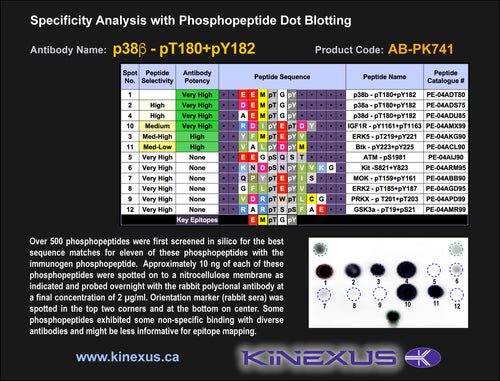Product Name:
p38b-pT180+pY182
Product Number:
ab-pk741
Target Full Name: Mitogen-activated protein-serine kinase p38 beta; Mitogen-activated protein kinase 11
Target Alias: MAPK11; MK11; P38 MAPK-beta; P38-2; P38b; PRKM11; SAPK2; Stress-activated protein kinase-2; p28b MARPK; p38Beta; CCDS14090.1; Q15759; ENSG00000185386
Product Type Specific: Protein kinase phosphosite-specific antibody
Antibody Code: PK741
Antibody Target Type: Phosphosite-specific
Antibody Phosphosite: T180+Y182
Protein UniProt: Q15759
Protein SigNET: Q15759
Antibody Type: Polyclonal
Antibody Host Species: Rabbit
Antibody Immunogen Source: Human p38b MAPK (MAPK11) sequence peptide Cat. No.: PE-04ADT80
Antibody Immunogen Sequence: EEM(pT)G(pY)(bA)C
Antibody Immunogen Description: Corresponds to amino acid residues E177 to Y182; In the protein kinase catalytic domain activation T loop region between subdomains VII and VIII.
Production Method: Corresponds to amino acid residues E177 to Y182; In the protein kinase catalytic domain activation T loop region between subdomains VII and VIII.
Antibody Modification: Protein kinase phosphosite-specific antibody
Antibody Concentration: 0.5 / 0.32 mg/ml
Storage Buffer: Phosphate buffered saline pH 7.4, 0.05% Thimerasol
Storage Conditions: For long term storage, keep frozen at -40°C or lower. Stock solution can be kept at +4°C for more than 3 months. Avoid repeated freeze-thaw cycles.
Product Use: Western blotting | Antibody microarray
Antibody Dilution Recommended: 2 µg/ml for immunoblotting
Antibody Potency: Medium immunoreactivity with immunogen peptide on dot blots.
Antibody Species Reactivity: Human
Antibody Positive Control: The observed molecular mass of the processed target protein on SDS-PAGE gels is reported to be around 40-48 kDa.
Antibody Specificity: High
Antibody Cross Reactivity: No significant cross-reactivities detected in EGFR-treated A431 cells, except for weak target protein and 4 weak cross-reactive proteins; Weak target detection and 4 weak cross-reactive proteins in phenylarsine oxide (PAO)+vanadate-treated HeLa. cells. Clean, but strong background >75 kDa in insulin-treated MCF7 cells.
Related Product 1: p38b-pT180+pY182 blocking peptide
Related Product 2: p38 pan-specific antibody (Cat. No.: AB-NK120-5)
Related Product 3: p38b-1 pan-specific antibody (Cat. No.: AB-NK248-1)
Related Product 4: p38b-2 pan-specific antibody (Cat. No.: AB-NK248-2)
Related Product 5: p38SelectideA - p38a MAPK (MAPK14) protein kinase substrate peptide
Related Product 6: p38Subtide - p38a MAPK (MAPK14) protein kinase substrate peptide
Related Product 7: p38 MAPK KinSub - p38 MAPK peptide substrate
Scientific Background: p38b (MAPK11) is a protein-serine/threonine kinase that is a member of the CMGC group of protein kinases in the MAPK family, and p38 subfamily. This kinase is moderate to highly expressed in most tested human tissues. p38b is activated by both proinflammatory cytokines and environmental stress. p38b is directly activated by phosphorylation at Y182 and probably T180 by MKK6 (MAP2K6, MEK6). Transcription factor ATF2/CREB2 has been shown to be a substrate of this kinase. Alternatively spliced transcript variants encoding the same protein have been observed. p38b has been linked with the development of inflammation and autoimmunity, diabetes and lung neuroendocrine carcinomas. Some of the targets of p38b, like p38a, are downstream kinases such as MSK1 (RPS6KA5) and MSK2 (RPS6KA4), which play important roles in the rapid induction of immediate-early genes in response to stress or mitogenic stimuli, either by inducing chromatin remodeling or by recruiting the transcription machinery.Two other kinase targets, MAPKAPK2 (MK2) and MAPKAPK3 (MK3), participate in the control of gene expression mostly at the post-transcriptional level. MKNK1/MNK1 and MKNK2/MNK2 are two other p38-activated protein kinases that regulate protein synthesis. In the nucleus, many transcription factors are phosphorylated and activated by p38 MAPK, including ATF1, ATF2, ATF6, ELK1, PTPRH, DDIT3, TP53/p53, MEF2C and MEF2A.




